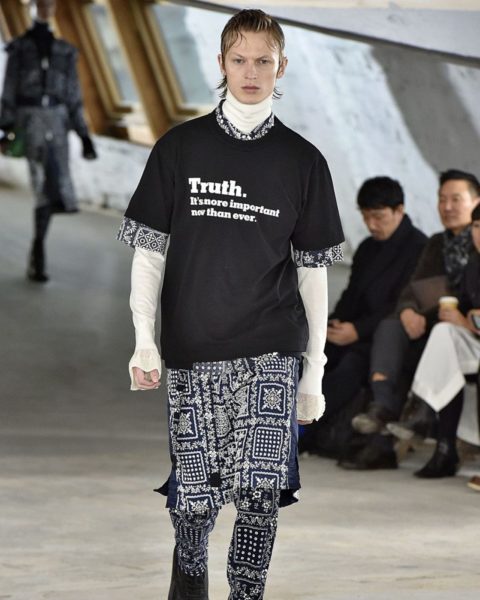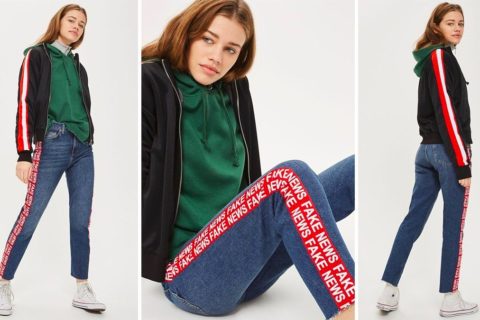How Fake News is Infiltrating Fashion
Balenciaga, Sacai and Alexander Wang have all hopped on the newsprint trend
In January, Topshop released a pair of jeans trumpeting the words “Fake News” down the side in a bold stripe of red. Naturally, the pants triggered a firestorm on social media with its casual use of Donald Trump’s favourite media diss. Vanessa Friedman of the New York Times summed up the controversy when she wrote, “Topshop…is not really known for its political positions, so the jeans smack of bandwagoning during a sensitive cultural moment.”
I’d go a step further to suggest that part of the reason why reactions to the jeans were so knee-jerkingly anti had to do with the fact it was impossible to gauge the sincerity of the message. Styled with a forest green hoodie and a black nylon zip-up bomber, it was hard to tell whether the Fake News pants were a condemnation of Trump or best paired with a “Make America Great Again” hat.
Since then, a growing number of fashion labels have produced news-themed garments and with the conventional wisdom that three makes a trend, it’s safe to say that news is teetering on the precipice of being a capital T trend. First, the Sacai menswear F/W 2018 collection featured oversized t-shirts emblazoned with the New York Times’ slogan, “Truth, it’s now more important than ever,” and Etudes delivered a near-identical collaboration featuring the Gray Lady’s Gothic logo on oversize scarves and tees. Alexander Wang collaborated with the New York Post’s gossip arm Page Six, on a line of newsprint-patterned sweat suits. Balenciaga’s Spring 2018 campaign featured a pissed-off looking Stella Tennant hiding from the paparazzi in an oversize newsprint button-down shirt, and Gabriela Hearst recently released a luxe-looking silk dress covered in all the news that’s fit to print. Wake up and smell the headlines.
Newsprint is a refreshing change from the brash slogan t-shirts that have dominated seasons past, like Dior’s “We Should All Be Feminists,” and Jonathan Simkhai’s “Feminist AF” tees. At this point, simply declaring yourself anything without performing the actions to back it up has started to ring hollow. We get it, you’re feminist. Now it’s time to read the fine print.
Newsprint clothing isn’t exactly new; I have a newsprint pencil skirt that I’ve owned since my days as a grungy, thrift store-obsessed teen that, miraculously, still fits. Back then, newsprint clothes were cool because Carrie Bradshaw wore a Dior newsprint dress designed by John Galliano on Sex and the City. The concept itself dates back to 1911, when Paul Poiret designed a newsprint dress using classified ads, and surrealist designer Elsa Schiaparelli designed her own version of a newsprint pattern in 1935.
Beth Dincuff, a fashion historian and professor at Parsons School of Design in NYC, says that “both Schiaparelli and Galliano’s prints acts as mediums for self expression that bypass any non-design room editing.” Elsa Schiaparelli’s newsprint pattern focused mainly on fashion news, with headlines like “Individuality Stressed at Paris Openings, and bland statements such as, “La Vie a Paris.” “Creating a print made from her choice of press clippings [was] a unique way of controlling her message,” Dincuff says. In contrast, Galliano’s newsprint pattern was comprised of somewhat self-aggrandizing reviews of his own collections. “Galliano would have had more artistic control in designing a print than he would have in writing a press release,” she says. “It’s interesting to note that both the Schiaparelli and the Galliano fabric feature images of the designers.”
Both the Schiaparelli and the Galliano versions of newsprint, alongside other 20th century iterations such as Moschino, are splashy and lighthearted, but the current day resurgence of the pattern has taken on a more serious tone, prioritizing survival over aesthetics. The valorization of the New York Times, a news source Donald Trump loves to demean as “failing,” feels particularly pointed. “It is about the importance of tolerance and accepting everyone,” Sacai designer Chitose Abe has said. Etudes designers Jeremy Egry and Aurelien Arbet told the press their intention was not to present a political message, “but obviously we want to support freedom of expression.”

The timing and prevalence of the newsprint trend suggests that fashion, which has typically been rooted in escapism and aspirational messaging, is coming down to earth. Political news has replaced celebrity gossip as the mainstay of current day conversation, and even Hollywood, a place seemingly not subject to terrestrial laws, seems to be making up for lost time with the launch of Time’s Up. Realism is replacing escapism as the appropriate reaction to what is happening in the world. Since we can no longer escape the constant, pulsating bad news cycle – nor should we – it’s become natural to appropriate it. With politics at the forefront of culture, the newsprint trend appears to be the fashion world’s acquiescence to the cultural conversation of the day.
If we can’t escape the news, we might as well wear it.








